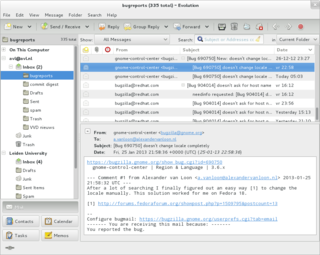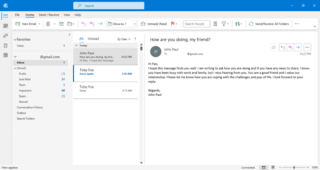Related Research Articles

Electronic mail is a method of transmitting and receiving messages using electronic devices. It was conceived in the late–20th century as the digital version of, or counterpart to, mail. Email is a ubiquitous and very widely used communication medium; in current use, an email address is often treated as a basic and necessary part of many processes in business, commerce, government, education, entertainment, and other spheres of daily life in most countries.
In computing, the Internet Message Access Protocol (IMAP) is an Internet standard protocol used by email clients to retrieve email messages from a mail server over a TCP/IP connection. IMAP is defined by RFC 9051.
The Lightweight Directory Access Protocol is an open, vendor-neutral, industry standard application protocol for accessing and maintaining distributed directory information services over an Internet Protocol (IP) network. Directory services play an important role in developing intranet and Internet applications by allowing the sharing of information about users, systems, networks, services, and applications throughout the network. As examples, directory services may provide any organized set of records, often with a hierarchical structure, such as a corporate email directory. Similarly, a telephone directory is a list of subscribers with an address and a phone number.
Multipurpose Internet Mail Extensions (MIME) is an Internet standard that extends the format of email messages to support text in character sets other than ASCII, as well as attachments of audio, video, images, and application programs. Message bodies may consist of multiple parts, and header information may be specified in non-ASCII character sets. Email messages with MIME formatting are typically transmitted with standard protocols, such as the Simple Mail Transfer Protocol (SMTP), the Post Office Protocol (POP), and the Internet Message Access Protocol (IMAP).
In computing, the Post Office Protocol (POP) is an application-layer Internet standard protocol used by e-mail clients to retrieve e-mail from a mail server. POP version 3 (POP3) is the version in common use, and along with IMAP the most common protocols for email retrieval.
The Simple Mail Transfer Protocol (SMTP) is an Internet standard communication protocol for electronic mail transmission. Mail servers and other message transfer agents use SMTP to send and receive mail messages. User-level email clients typically use SMTP only for sending messages to a mail server for relaying, and typically submit outgoing email to the mail server on port 587 or 465 per RFC 8314. For retrieving messages, IMAP is standard, but proprietary servers also often implement proprietary protocols, e.g., Exchange ActiveSync.

An email client, email reader or, more formally, message user agent (MUA) or mail user agent is a computer program used to access and manage a user's email.

Microsoft Outlook is a personal information manager software system from Microsoft, available as a part of the Microsoft Office and Microsoft 365 software suites. Though primarily an email client, Outlook also includes such functions as calendaring, task managing, contact managing, note-taking, journal logging and web browsing, and has also become a popular email client for many businesses.

Pegasus Mail is a proprietary email client developed by David Harris. It was originally released in 1990 for internal and external mail on NetWare networks with MS-DOS and later Apple Macintosh clients. It was subsequently ported to Microsoft Windows, which is now the only platform actively supported. Previously freeware, Pegasus Mail is now donationware.
The following tables compare general and technical features of notable email client programs.
Push technology or server push is a style of Internet-based communication where the request for a given transaction is initiated by the publisher or central server. It is contrasted with pull / get, where the request for the transmission of information is initiated by the receiver or client.
The UW IMAP server was the reference server implementation of the Internet Message Access Protocol. It was developed at the University of Washington by Mark Crispin and others.
In cryptography, CRAM-MD5 is a challenge–response authentication mechanism (CRAM) based on the HMAC-MD5 algorithm. As one of the mechanisms supported by the Simple Authentication and Security Layer (SASL), it is often used in email software as part of SMTP Authentication and for the authentication of POP and IMAP users, as well as in applications implementing LDAP, XMPP, BEEP, and other protocols.
Push email is an email system that provides an always-on capability, in which when new email arrives at the mail delivery agent (MDA), it is immediately, actively transferred (pushed) by the MDA to the mail user agent (MUA), also called the email client, so that the end-user can see incoming email immediately. This is in contrast with systems that check for new incoming mail every so often, on a schedule. Email clients include smartphones and, less strictly, IMAP personal computer mail applications.

An e-mail agent is a program that is part of the e-mail infrastructure, from composition by sender, to transfer across the network, to viewing by recipient. The best-known are message user agents and message transfer agents, but finer divisions exist.
Exchange ActiveSync is a proprietary protocol designed for the synchronization of email, contacts, calendar, tasks, and notes from a messaging server to a smartphone or other mobile devices. The protocol also provides mobile device management and policy controls. The protocol is based on XML. The mobile device communicates over HTTP or HTTPS.

OfflineIMAP is IMAP synchronization utility software, capable of synchronizing mail on IMAP server with local Maildir folder or another server.
Mail is an email client developed by Microsoft and included in Windows Vista and later versions of Windows. It is available as the successor to Outlook Express, which was either included with, or released for Internet Explorer 3.0 and later versions of Internet Explorer.
Kopano is an open-source groupware application suite originally based on Zarafa. The initial version of Kopano Core (KC) was forked from the then-current release of Zarafa Collaboration Platform, and superseded ZCP in terms of lineage as ZCP switched to maintenance mode with patches flowing from KC. Kopano WebApp similarly descended from Zarafa WebApp. Since October 2017, Kopano Core is also known more specifically as Kopano Groupware Core, since Kopano B.V. developed more products that were not directly requiring groupware components.
GyazMail is an email client for macOS, developed and maintained by Japanese programmer Goichi Hirakawa. It supports the POP3, IMAP and SMTP protocols. Its handling of multiple email accounts includes local mailboxes.
References
- ↑ Wang, Xiao Lei (2005). "Performance evaluations for multimedia applications over PR-SCTP" (PDF). University of British Columbia. pp. xii. Retrieved December 1, 2012.
- ↑ "SMAP" . Retrieved December 1, 2012.